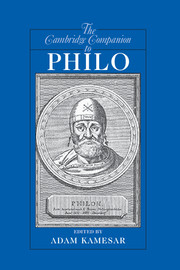9 - Philo and Rabbinic Literature
from Part 3 - Philo’s Influence and Significance
Published online by Cambridge University Press: 28 November 2009
Summary
Most scholars agree that there is a significant relationship between Philo and rabbinic literature, yet one looks in vain for an explicit reference to him in that vast corpus of writings. If the Rabbis were aware of his voluminous oeuvre and made occasional use of his teachings, the fact remains, nevertheless, that their attitude to this Alexandrian Jewish sage was at best ambivalent. The reasons for this are not difficult to discern, and may readily be glimpsed by examining the evaluation of Philo made by Azariah de' Rossi, the most influential forerunner of the modern science of Judaism, who, in the sixteenth century, rediscovered for the Jewish world the virtually forgotten Philo. Although de' Rossi greatly appreciated Philo's philosophical ability, his highly ambivalent attitude toward him is clearly revealed in a number of criticisms that revolve around Philo's ignorance of Hebrew and Aramaic, his belief in the eternity of matter, his allegorization of Scripture, and his deviation from Palestinian halakhah. 'This last charge', he said, 'is weighty enough to sink him like lead into bottomless waters. . . . you will not come across any indication that he took upon himself the Oral Tradition alongside the Written Torah.' In arguing this point, de' Rossi cites numerous examples of Philo's adherence to the literal interpretation of Pentateuchal laws in contradiction to the rabbinic understanding of them. He thus refused to decide whether Philo's work is 'pure or impure', and although he would not refer to Philo as Rabbi or hakham, because he detected sectarian or Essene-Boethusian proclivities in him, neither would he condemn him as a heretic, preferring to call him instead Yedidyah the Alexandrian and treating him merely as one of the sages of the non-Jewish world.
- Type
- Chapter
- Information
- The Cambridge Companion to Philo , pp. 231 - 254Publisher: Cambridge University PressPrint publication year: 2009
- 3
- Cited by

